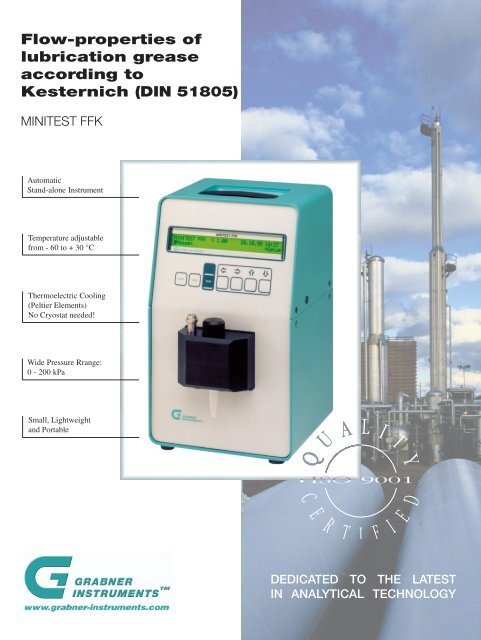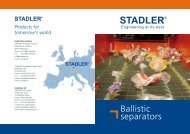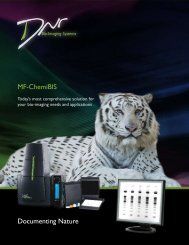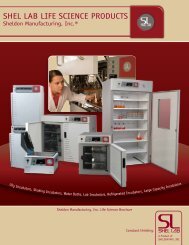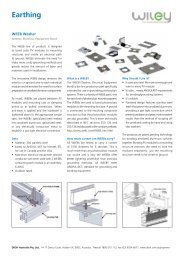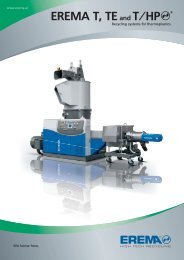Flow-properties of lubrication grease according to Kesternich (DIN 51805)
Minitest FFK Specifications.pdf
Minitest FFK Specifications.pdf
- No tags were found...
Create successful ePaper yourself
Turn your PDF publications into a flip-book with our unique Google optimized e-Paper software.
<strong>Flow</strong>-<strong>properties</strong> <strong>of</strong><br />
<strong>lubrication</strong> <strong>grease</strong><br />
<strong>according</strong> <strong>to</strong><br />
<strong>Kesternich</strong> (<strong>DIN</strong> <strong>51805</strong>)<br />
MINITEST FFK<br />
Au<strong>to</strong>matic<br />
Stand-alone Instrument<br />
Temperature adjustable<br />
from - 60 <strong>to</strong> + 30 °C<br />
Thermoelectric Cooling<br />
(Peltier Elements)<br />
No Cryostat needed!<br />
Wide Pressure Rrange:<br />
0 - 200 kPa<br />
Small, Lightweight<br />
and Portable<br />
DEDICATED TO THE LATEST<br />
IN ANALYTICAL TECHNOLOGY
Applications<br />
<strong>Flow</strong>-<strong>properties</strong> <strong>of</strong> <strong>lubrication</strong> <strong>grease</strong> at low temperatures are a measure<br />
<strong>of</strong> great significance for central <strong>lubrication</strong> systems <strong>of</strong> vehicles and<br />
machineries. This property can best be measured <strong>according</strong> <strong>to</strong> the<br />
method <strong>of</strong> <strong>Kesternich</strong> (<strong>DIN</strong> 5108).<br />
MINITEST FFK is an instrument for the determination <strong>of</strong> the flow<br />
pressure <strong>of</strong> lubricating <strong>grease</strong> at temperatures down <strong>to</strong> -60°C.<br />
Design <strong>of</strong><br />
MINITEST FFK<br />
Advanced<br />
Technology<br />
The original manual and time-consuming method is now au<strong>to</strong>mated<br />
in MINITEST FFK. The measuring range is extended far below the<br />
original test method.<br />
Temperature control is performed with Peltier elements and eliminates<br />
the use <strong>of</strong> a large and expensive cryostat.<br />
No further accessories are necessary!<br />
The instrument has a standardized measuring nozzle (1) and a<br />
thermostatic block (2). The measuring system is firmly closed with a<br />
seal s<strong>to</strong>pper (3). The system is closed at the bot<strong>to</strong>m with an Eppendorf<br />
flask (4) <strong>to</strong> protect the test nozzle against condensation <strong>of</strong> water. This<br />
flask is also collecting the <strong>lubrication</strong> <strong>grease</strong> after the test.<br />
The test pressure is generated by a mo<strong>to</strong>r-driven pis<strong>to</strong>n (6) and measured<br />
with a precision pressure transducer (5).<br />
The required low temperature is regulated by a cascade block (8)<br />
with Peltier elements (7). Down <strong>to</strong> temperatures <strong>of</strong> -30°C the heat is<br />
dissipated over a heat exchanger (9). For lower temperatures the heat<br />
exchanger has <strong>to</strong> be cooled with tap water.<br />
Sample Handling<br />
A layer <strong>of</strong> the <strong>grease</strong> <strong>to</strong> be tested is put on a glass plate without air<br />
bubbles. The measuring nozzle is than pressed multiple times on<strong>to</strong> the<br />
layer <strong>of</strong> <strong>lubrication</strong> <strong>grease</strong> until it is filled with <strong>grease</strong>.<br />
The full nozzle is inserted in<strong>to</strong> the thermostatically controlled aluminum<br />
block <strong>of</strong> the tester and the chamber is airsealed.<br />
Measuring<br />
Procedure<br />
The test temperature, the equilibrium time, the expected flow pressure<br />
and the pressure increase for each step are programmed.<br />
For high flow pressures, a starting pressure above barometric can be set<br />
<strong>to</strong> limit the measuring time.<br />
The test is performed au<strong>to</strong>matically. When the test temperature is<br />
reached, the equilibrium time <strong>of</strong> up <strong>to</strong> two hours is started. After the<br />
equilibrium time the pressure above the sample nozzle is increased in<br />
steps until a sudden pressure decrease, indicating that the <strong>grease</strong> is<br />
pressed through the nozzle. The test is s<strong>to</strong>pped and the last pressure<br />
value is displayed as the flow pressure <strong>according</strong> <strong>to</strong> <strong>Kesternich</strong>.<br />
Technical<br />
Data<br />
Test temperature:<br />
Temperature resolution:<br />
Pressure range:<br />
Pressure resolution:<br />
Communication languages:<br />
Power supply:<br />
W x H x D:<br />
Weight:<br />
- 60 <strong>to</strong> + 30 °C (-76 <strong>to</strong> 86 °F)<br />
+/- 0.1°C (32.18 °F)<br />
0 <strong>to</strong> 200 kPa (0 <strong>to</strong> 29 psi)<br />
+/- 0.1 kPa (0.0145 psi)<br />
German, English<br />
100/120/230/240 V,50/60 Hz,120<br />
W12V/10 A DC<br />
196 x 315 x 175 mm<br />
10 kg (22 lbs)<br />
Distribu<strong>to</strong>r:<br />
TM<br />
GRABNER INSTRUMENTS<br />
Dr. Ot<strong>to</strong>-Neurath-Gasse 1<br />
A-1220 Vienna/Austria<br />
Tel.: +43/1/282 16 27-0<br />
Fax: +43/1/280 73 34<br />
e-mail: <strong>of</strong>fice@grabner-instruments.com<br />
http://www.grabner-instruments.com<br />
FFK-103 (Specifications are subject <strong>to</strong> change without notice)<br />
© Copyright 2002, Grabner Instruments


